All U.S. Troops Home Now
• U.S. War Drills in Korea are Crimes Against the Peace
• National Campaign to End the Korean War Plans July Actions
• Sign Onto the Campaign to End the Korean War
• Jeju Island Resistance Movement Continues Demand for No Military Base
• “We Want to Live in Peace with Justice for the Weak”
• No Naval Base on Jeju Island — Nodutdol for Korean Community Development
• U.S. to Shift Bulk of Navy Ships to Asia-Pacific
U.S. War Drills in Korea Are
Crimes Against the Peace
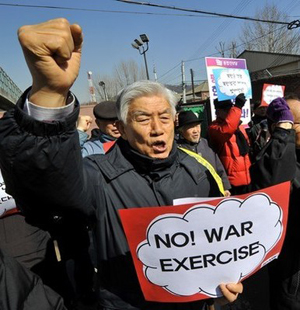 On June 22 the U.S. and South Korea conducted massive live-fire war drills just 15 miles south of the border with the Democratic People’s Republic of Korea (DPRK). According to military sources, the war drill is the largest since the Korean War. It included more than 2,000 troops, A-10 Thunderbolt fighter jets, one of the deadliest U.S. jets with “tank-buster” guns, used extensively against Iraq, U.S. Apache attack helicopters, tanks and missiles. Huge explosions occurred and aircraft and helicopters repeatedly flew over the area, chosen purposely — and dangerously — close to the DPRK border.
On June 22 the U.S. and South Korea conducted massive live-fire war drills just 15 miles south of the border with the Democratic People’s Republic of Korea (DPRK). According to military sources, the war drill is the largest since the Korean War. It included more than 2,000 troops, A-10 Thunderbolt fighter jets, one of the deadliest U.S. jets with “tank-buster” guns, used extensively against Iraq, U.S. Apache attack helicopters, tanks and missiles. Huge explosions occurred and aircraft and helicopters repeatedly flew over the area, chosen purposely — and dangerously — close to the DPRK border.
The one-day land war drill was accompanied by a two-day naval war drill that included South Korea and Japan, June 21-22. These were conducted near the southern Korean island of Jeju, where the U.S. has South Korea building a massive new naval base against the broad opposition of the island’s inhabitants. The island has a strategic military position, lying between Korea and Japan and close to China. The U.S. reports this is the first time Japan has been involved in trilateral war drills near the Korean coast.
The naval war drill is an effort to force Koreans to accept participation of Japan in military actions in the region. Japan is known for its crimes of occupying Korea and its long history of aggression in the region. It is also an effort to engage the Japanese military forces in more aggressive actions, something that is counter to the Japanese Constitution, instituted after WWII, which outlaws use of Japanese forces abroad.
Demonstrations opposing the war drills and demanding removal of U.S. forces occurred in both Korea and Japan. Protests also continue at Jeju to block building of this new U.S.-backed military base in Korea (see articles below).
Three more days of naval games with the U.S. and South Korea will take place from June 23-25 that include the aircraft supercarrier USS George Washington, which has about 90 aircraft and helicopters and 3,000 troops. The carrier is one of 10 U.S. ships and submarines taking part in these war drills in the Yellow Sea, which lies between China and Korea. China considers the Yellow Sea part of her coastal waters and has urged the U.S. not to conduct war drills in the area.
The U.S. made clear the provocative and criminal nature of the drills, which are preparations for aggressive war and thus crimes against the peace. In addition to conducting them close to the border with the DPRK and in the Yellow Sea near China, during the land-drills a DPRK flag was used as a target for the bombings by both U.S. and South Korean forces. The date for the drills also coincides with the anniversary of the start of the U.S. aggressive war against Korea, June 25, 1950. Further, reflecting the U.S. “might makes right” stand, South Korea's Defense Ministry said in a statement that the drills were meant as a “clear warning” against the DPRK. The spokesman said, “The war is not over. We should face the stark reality where a war can occur any time.” He added, “We think the joint exercise will be the largest ever in terms of scale. North Korea calls it a provocation, but a military cannot be competent if it does not exercise.”
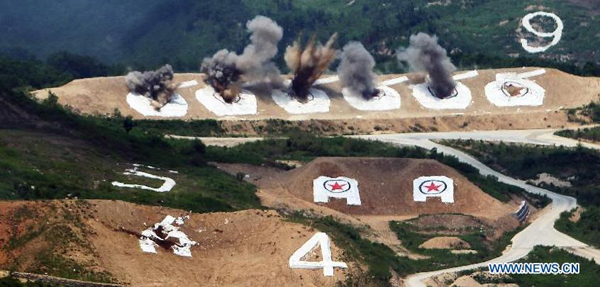
U.S. and South Korea bombing drills, using flag of Democratic People's Republic of Korea as a target
The U.S. occupies south Korea with more than 28,500 troops and their bases and weaponry, including nuclear weapons on subs and supercarriers. It is the U.S. that provides south Korea with weapons and aircraft and trains them. The U.S. military commands the south Korean forces and is also using these drills to integrate the Japanese military into its unified structure. The U.S. also occupies Japan with about 38,000 troops and bases.
It is the U.S. that has refused to sign a peace treaty with Korea. It is the U.S. that organizes and conducts these provocative war games, which are a display of military might in the region. They are directed against the Koreans and Chinese, and a grave danger to all the peoples of the region and the world.
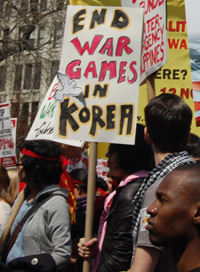 All preparations for aggressive war, including propaganda for such wars, are crimes. Indeed they are considered among the worst crimes. As part of efforts to protect world peace such preparations for aggression are outlawed as without them the wars themselves would not take place. As the military spokesman said, “A military cannot be competent if it does not exercise.” These war drills were in no way designed for training to defend Korea or Japan and certainly not the U.S. located thousands of miles away. They were designed for training in aggression, for heightening tensions among Koreans — why else use the DPRK flag as a target? Why involve Japan?
All preparations for aggressive war, including propaganda for such wars, are crimes. Indeed they are considered among the worst crimes. As part of efforts to protect world peace such preparations for aggression are outlawed as without them the wars themselves would not take place. As the military spokesman said, “A military cannot be competent if it does not exercise.” These war drills were in no way designed for training to defend Korea or Japan and certainly not the U.S. located thousands of miles away. They were designed for training in aggression, for heightening tensions among Koreans — why else use the DPRK flag as a target? Why involve Japan?
The “warning” being issued to the DPRK and China is that the U.S. is increasing its preparations for aggressive war and organizing to drag Japan into it. The war drills are dangerous, criminal and broadly opposed by peoples in the region and the U.S. The peoples’ common demand is end war drills, close U.S. bases and Bring All U.S. Troops Home Now! That is what is needed for peace and security of the peoples in the region and worldwide.
[TOP]
National Campaign to End the Korean War Plans July Actions
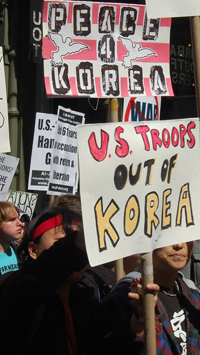 The National Campaign to End the Korean War, a U.S. organization fighting to have the U.S. sign a peace treaty with Korea and end the current state of war, will be sending people to Washington July 27. The date marks the anniversary of the signing of the Korean War Armistice, July 27, 1953. The Campaign is organizing in the U.S. to help secure peace on the Korean peninsula. It is calling on President Barack Obama and Congress to sign a peace treaty as an important step in easing tensions and normalizing relations with the Democratic People’s Republic of Korea (DPRK) and all the Korean people.
The National Campaign to End the Korean War, a U.S. organization fighting to have the U.S. sign a peace treaty with Korea and end the current state of war, will be sending people to Washington July 27. The date marks the anniversary of the signing of the Korean War Armistice, July 27, 1953. The Campaign is organizing in the U.S. to help secure peace on the Korean peninsula. It is calling on President Barack Obama and Congress to sign a peace treaty as an important step in easing tensions and normalizing relations with the Democratic People’s Republic of Korea (DPRK) and all the Korean people.
The Armistice Agreement signed in 1953 provided for a cease-fire and also specifically called for a peace treaty to be signed shortly thereafter. The armistice itself showed the victory of the Koreans over the U.S., in that it was signed in Pamnunjon on the DPRK side of the Demilitarized Zone.
The victory of the Koreans over the U.S. marked the first military defeat for the U.S. in the 20th century and showed that a people organized and determined to defend their just cause could defeat U.S. imperialism. The Korean victory served as inspiration to all, including the African liberation struggles unfolding in the period and for the heroic Vietnamese, whose resistance also brought defeat for the U.S. In part to pursue its drive for world domination, and also as revenge against the Koreans for defeating them, the U.S. continues to step up its war plans against Korea and refuses to sign a peace treaty.
The aim of the U.S. today is the same as it was in 1950 — to take over the entire Korean peninsula as a launching pad for its takeover of Asia and then the world. But as with the Korean War itself, all the attempts of the U.S. to realize its domination of the region have failed. These include its occupation of the Korean peninsula with almost 30,000 troops, the ongoing attempts to sabotage the Korean people's movement for national reunification, and its engineering of one puppet regime after another in the south, including the present regime of Lee Myung Bak. Its continuous disinformation and propaganda that the "problem" in Korea is the "threat" from the DPRK — also has failed.
The U.S. has failed to silence the 70 million Koreans who are demanding with one voice the peaceful and independent reunification of their homeland, free from U.S. imperialist interference. It has failed to silence people in the U.S. who stand against aggressive war and oppose the criminal role of the U.S. imperialists in Korea, from 1945 to the present. The resolute struggle of the Korean people stands today, as in the past, as a principled and determined example for all the peoples of the world fighting against imperialist domination.
The DPRK has proposed the signing of a formal peace treaty with the U.S. several times. So far the U.S., which has violated all the terms of the armistice agreement since the time it was signed, has also rejected these proposals. It has instead mounted war drills, with each one larger than the last in the past few years.
The U.S. must be held accountable for its crimes on the Korean peninsula and be forced to sign a formal peace treaty with the DPRK. This is the united demand of Koreans everywhere, and of all peace and justice loving people in the U.S. and worldwide. United actions are being planned in the U.S., Korea and worldwide next year on July 27, 2013, the 60th anniversary of the signing of the Armistice. The demand of the peoples is firm: Sign the Peace Treaty with Korea! All U.S. Troops Home Now!
[TOP]
Sign Onto the Campaign to End the Korean War
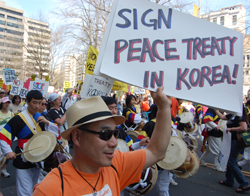 The lingering state of war in Korea is a major contributor to instability in Asia and is a violation of the 1953 Armistice Agreement and United Nations Resolution 39/11 establishing a people’s Right to Peace. In addition, the United States spends tens of billions of dollars in military expenditures and maintains more than 28,500 troops in South Korea in harm's way.
The lingering state of war in Korea is a major contributor to instability in Asia and is a violation of the 1953 Armistice Agreement and United Nations Resolution 39/11 establishing a people’s Right to Peace. In addition, the United States spends tens of billions of dollars in military expenditures and maintains more than 28,500 troops in South Korea in harm's way.
Recognizing the past contributions of the American people in ending the U.S. war in Vietnam, we are now calling on the American people to end the lingering Korean War — the longest and costliest war the U.S. government has waged in its history. After more than a half century, it is high time for the United States to end the Korean War finally and officially by replacing the outdated, broken Armistice Agreement of 1953 with a peace treaty.
Call to End the Korean War
“When nations and peoples allow themselves to be defined by differences, the gulf between them widens. When we fail to pursue peace, then it stays forever beyond our grasp.” President Barack Obama, Prague, April 5, 2009
As a nationwide coalition of Americans of Korean descent and other concerned Americans, we applaud President Obama’s call to a foreign policy that emphasizes diplomacy and negotiation, and hope that this will bring about a lasting peace on the Korean peninsula. An Armistice Agreement signed by the United States in 1953 called for a peace treaty and removal of all foreign troops from Korea. No peace treaty has been signed and we spend tens of billions of dollars each year in maintaining provocative military exercises and military buildups in South Korea, as well as stationing some 28,500 U.S. troops in dozens of posts and bases.
We call upon President Obama to make the signing of a peace treaty with North Korea (Democratic People’s Republic of Korea, DPRK) a top priority of United States foreign policy. In addition, moving toward normal diplomatic relations would be a practical step toward resolving differences over nuclear proliferation and arms control, human rights, and economic reform. Relationship builds trust and understanding and provides a forum for further dialogue.
The United States divided Korea and plays a unique role in its peace and reconciliation. Hearings by the South Korean Truth and Reconciliation Commission revealed that our government was present at or played a part in massacres during the Korean War. The best way to atone for past mistakes and console the souls of the millions who died in the horrific fighting in the 1950-1953 period is to build permanent peace, justice and reconciliation on the Korean Peninsula.
We urgently request that the Congress and the Obama Administration address the peace treaty issue as soon as possible so that more than 70 million people living on the Korean peninsula and their families here in the United States can at last be freed from the fear of war. Only then can other major regional and global problems be resolved.
It is time to end the Korean War. As James Laney, former U.S. ambassador to South Korea, said in Seoul:
"... One item should be at the top of the agenda, however, in order to remove all unnecessary obstacles to progress, which is the establishment of a peace treaty to replace the truce that has been in place since 1953. One of the things that have bedeviled all talks until now is the unresolved status of the Korean War. A peace treaty would provide a baseline for relationships, eliminating the question of the other’s legitimacy and its right to exist. Absent such a peace treaty, every dispute presents afresh the question of the other side’s legitimacy."
Therefore the following organizations, scholars of Korean Relations and individuals stand together for:
1. A permanent peace settlement on the Korean Peninsula through an official end to the Korean War with a peace treaty.
2. Establishment of a new U.S. policy toward Korea based on normalized relations and a greater respect for the fundamental human rights of the Korean people to self-determination, peace, human security, and development.
Co-Signing Initiators
National Association of Korean Americans (NAKA)
National Committee for Peace in Korea (NCPK)
National Lawyers Guild, Korean Peace Project
North American Network for Peace in Korea (NANPK)
Veterans for Peace, Korea Peace Campaign
(For full listing of signers and to sign the petition go to www.endthekoreanwar.org and click on Sign Petition for Peace)
[TOP]
Jeju Island Resistance Movement
Continues Demand for No Military Base
No Military Base! Yes to Life and Peace Island!
Stop the destruction and human rights violations
(As part of U.S. war preparations for dominating Asia, it has the South Korean government building yet another naval base at Jeju Island. The Island’s people are known for their resistance to the U.S. and defense of the rights of the Korean people. Like demonstrators everywhere, they have been contending with police repression of their right to resist, including arrests, laws against group protests and more. Jeju Island is also home to great environmental treasures, considered by the UN as a World Heritage area to be preserved. The construction is damaging Jeju’s pristine fresh and sea waters, the Gureombi Rock is being blasted to pieces, and fish and other sea life endangered. The people of Gangjeong village, where the base is being built, voted overwhelmingly to oppose construction and have been protesting construction for close to six years. They oppose destruction of their villages and farms and reject use of their island for U.S. war plans. We reprint below items from the newsletter of the resistance in Gangjeong, outlining some of the recent developments.)
* * *
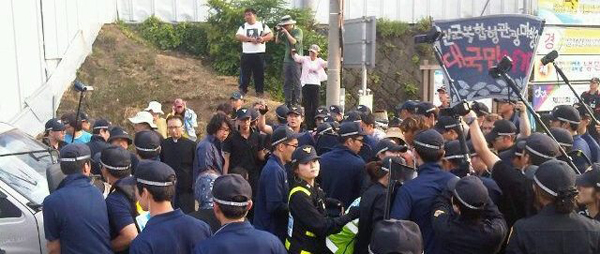
Protest on Jeju Island, June 11, 2012. Police block demonstrators trying to stop cement mixer trucks from entering the gates of the naval base construction site. (Save Jeju)
“There is no Jeju Island Governor anymore!” On May 24 a mock funeral portrait of Jeju Island Governor Woo was burned and stamped on by Gangjeong villagers. It has been revealed that he does not have the will to order the Korean Navy to stop construction (destruction) of its base at Jeju. For a long time, he has utilized stalling tactics and avoided deciding between the central government and Gangjeong villagers. However, it seems certain that he stands by the government and actually permits construction of the military base even though he knows that the construction has many problems. Therefore, five leaders of the resistance, including Gangjeong Mayor Kang Dong-Kyun, shaved their head in protest of the governor’s dubious decision while announcing, “A new struggle to make him resign has begun!”
Moreover, while the environmental destruction issues have been raised, there have recently also been questions posed by the Jeju media that there are illegal and unreliable points in the process of the caisson production (a caisson is a large, in this case 8 story high, 8,000 ton watertight structure used to work on the foundations of bridge and port piers —VOR ed). It turned out that Samsung C & T used shorter caisson rods than legally allowed.
Despite all the hardships, the people’s efforts to save the village are spreading far nationwide, especially in Seoul. On May 21 a Catholic mass to stop the Jeju military base and say No to the designation of Gangjeong village as military zone was held in front of the Integrated Government Building in Seoul. About 500 people gathered at the mass and sang and danced together. Moreover, they encouraged each other to maintain the resistance in the effort to save Gangjeong.
On May 22, UN Biodiversity Day, the Gangjeong village reported that the numbers of sweet fish in the Gangjeong stream have rapidly decreased due to the naval base construction (destruction). The sweet fish normally return from the sea to the stream from March to May, but blasting at the Gureombi Rock and underwater coincided with the annual return and is suspected of being the cause of reduction of sweet fish.
Based on the result of activities by the citizens’ monitoring committee on the illegal naval base construction, the Gangjeong village committee to stop the naval base has submitted proof of the Navy’s illegal construction practices to the Island government, demanding that the governor order construction to stop. The villagers’ press release included the illegal and unreliable caisson production by Samsung C&T, the company contracted to do the work.
Caissons are giant structures about 10 stories high and 8,800 tons each. It is vital that the steel frames for these structures be built strictly according to standards for them. However, the news daily Jeju Sori, revealed that the lower part of the caissons are connected with reinforcing rods of 800mm (about 31.5 inches) while the upper part is connected with far shorter rods of 200 mm (about 8 inches). According to the person informing the Jeju Sori, the strength of structure is weaker when the reinforcing rods are shorter. He also said, “If caissons are unreliably constructed, the possibility of damage by shocks due to sea waves and big military vessels when they come alongside the pier becomes higher. Verification of caisson dimensions and structure becomes impossible once those caissons are thrown into the sea.” The Samsung C & T plans to throw 57 caissons into the Gangjeong Sea over the coming 19 months.
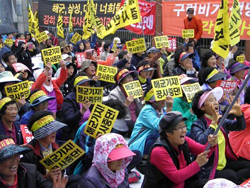 On May 23 the Jeju media detailed the villagers’ press release of May 22 with some photos. The contents included: (1) The noise level of the construction site exceeds standard levels. (2) Dredging was done despite damage in the silt protection layer. Further, as a result of citizens’ underwater monitoring, it was found that floating (to protect the sea life and coral reefs) was installed on the surface and there was nothing underneath (floating is then only decoration?) (3) The construction was not postponed even during a period of strong winds, which carried dust from the construction site and deposited it onto farmhouses, damaging the homes. The Jeju Island government is in dereliction of its duties in failing to enforce construction standards and refusing to stop construction (destruction). […]
On May 23 the Jeju media detailed the villagers’ press release of May 22 with some photos. The contents included: (1) The noise level of the construction site exceeds standard levels. (2) Dredging was done despite damage in the silt protection layer. Further, as a result of citizens’ underwater monitoring, it was found that floating (to protect the sea life and coral reefs) was installed on the surface and there was nothing underneath (floating is then only decoration?) (3) The construction was not postponed even during a period of strong winds, which carried dust from the construction site and deposited it onto farmhouses, damaging the homes. The Jeju Island government is in dereliction of its duties in failing to enforce construction standards and refusing to stop construction (destruction). […]
On May 26 more protests were initiated by Catholic priests on Jeju. A candlelight vigil was held in front of the main gate to the construction site. Other Catholic priests protested after mass at 11am. They sat down for lunch in front of the gate in robes. They were roughed up by company thugs. When the cement mixer trucks began to enter the area, a man climbed up on a truck with a flag of No naval base! He persisted for almost eight hours. Meanwhile, another priest laid down in front of the gate of the naval base project committee complex area to also block cement mixer trucks’ entry. He remained until 4pm.
Protests continued until 8pm and people then held a candlelight vigil at the site. Tens of teenage students from a school visiting the village joined in with their joyful music performance.
[TOP]
“We Want to Live in Peace with Justice for the Weak”
(Below is an excerpt from Dr. Song’s statement to the Jeju court May 17. He was arrested and imprisoned for resisting construction of the base at Gangjeong.)
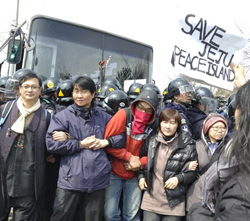 I am now confined in prison during my trial, charged with the misdemeanors of obstruction of ocean construction, property destruction and obstruction of business. When I was in Gangjeong what I experienced was that powerless people who long for justice are gagged and on their knees, forcibly silenced by the strength of the unjust. Have you ever listened to the pent-up anger of farmers who have forcibly lost their land? Now Gangjeong is filled with threats and fraud and the people trying to stop this are being arrested in the name of the law.
I am now confined in prison during my trial, charged with the misdemeanors of obstruction of ocean construction, property destruction and obstruction of business. When I was in Gangjeong what I experienced was that powerless people who long for justice are gagged and on their knees, forcibly silenced by the strength of the unjust. Have you ever listened to the pent-up anger of farmers who have forcibly lost their land? Now Gangjeong is filled with threats and fraud and the people trying to stop this are being arrested in the name of the law.
Judge Park Jae-Hyun dismissed the first lawsuit filed by the Gangjeong villagers on December 15, 2010 saying that the villagers could not be plaintiffs regarding the conservation of Gangjeong because there was no direct, specific, individual who would profit from rescinding the illegal annulment of the absolute conservation area. On May 18, 2011, Judge Bang Ju-Sung also dismissed a second lawsuit with the extraordinary judgment that it was the ground water, ecosystem and environment around Gangjeong that was being damaged, not the villagers themselves. So then according to his ruling, Halmangmul [a famous fresh water spring on Gureombi rock] and the red foot crab or narrow mouthed toad [endangered species living on Gurcombi rock] should be the plaintiffs?
Meanwhile, the Seogwipo police are used to arrest and charge the villagers very easily, but the captain of the Samsung C&T Corporation barge who twice illegally brought in caisson to drop in the Gangjeong Sea without the required ship inspections, was only given a fine without any detention. Furthermore at the time that barge came, the villagers and activists attempts to monitor its action was totally blocked by the land police and coast guard. And the coast guard lied, claiming that the barge had gotten a temporary permit.
On May 10, the Gangjeong villagers applied for an injunction against the prohibition of group protests but Judge Oh Hyun-gyu dismissed it. The Jeju court once again put a gag on the mouths of villagers. The court prohibits freedom of assembly and freedom of expression, which are the most basic constitutional rights. How then can the villagers express their opinion?
If this court is truly just, then the people who should stand in the dock are not us, but the Navy who disturbs our constitutional order, the construction industry conglomerates who squander our taxes, the police who align with and protect those interests, Jeju Governor Woo Keun-Min who neglects his duties and the judges and prosecuters of the Jeju court who have become slaves to power.
[TOP]
No Naval Base on Jeju Island
Nodutdol for Korean Community Development
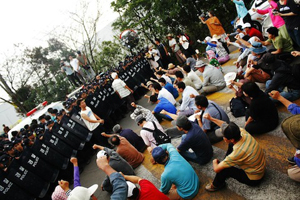 As international media herald the selection of Jeju Island as one of the “New 7 Wonders of Nature,” Nodutdol for Korean Community Development and the Alliance of Scholars Concerned about Korea call attention to the ugly threat of militarism that gives the lie to this designation. We join a growing worldwide movement in support of Jeju villagers and other South Korean democracy activists who have courageously resisted the building of a massive naval base in Gangjeong village. […]
As international media herald the selection of Jeju Island as one of the “New 7 Wonders of Nature,” Nodutdol for Korean Community Development and the Alliance of Scholars Concerned about Korea call attention to the ugly threat of militarism that gives the lie to this designation. We join a growing worldwide movement in support of Jeju villagers and other South Korean democracy activists who have courageously resisted the building of a massive naval base in Gangjeong village. […]
Due to be operational by 2014, the massive naval base, slated to host 20 warships, nuclear aircraft carriers, nuclear submarines, and two Aegis destroyers integrated within the US Missile Defense System, stands to destroy a UNESCO World Heritage site, a UNESCO biosphere reserve, and a government-recognized “absolute preservation area” characterized by rare rock formations, abundant and fertile farmlands, pristine fresh and sea waters, and endangered animal species. Rich in biodiversity and natural beauty, Gangjeong is also home to Bronze Age artifacts, making this region of inestimable archaeological value, as well.
The human costs are enormous. At stake are the sea- and land-based livelihoods of women divers, fishermen, and farmers who have been displaced from their jobs and their homes, as well as local self-governance processes. Although 94 percent of Gangjeong residents have voted against the construction of the naval base, the Seoul central government and the South Korean military have forcibly proceeded with construction, wielding police violence and trumped-up legal charges to quash resistance.
We call attention to the fact that since 2007, the people of Gangjeong have used every democratic means of protest, including squatting on government-seized farmlands (i.e., their lands) and placing their bodies below or on construction machinery, in order to halt the building of the base. With growing global attention to the Jeju resistance, the South Korean government has intensified its crackdown, recently dispatching over 1,000 riot police from the mainland to suppress and detain protesters so as to clear the way for construction. […]
We recall the past as troubling precedent for the present. Although Jeju Island today is known as a spectacularly beautiful tourist destination, it was a historical site of resistance that was met by state-sponsored counterrevolutionary violence in 1948. Protesting the holding of separate elections in the South that stood to cement the U.S.-authored division of the Korean peninsula and the formation of two distinct regimes in the north and the south, the people of Jeju were branded “Communists” and the island deemed a “red island.” At least one-tenth of the island population was ruthlessly slaughtered by South Korean forces and fascist youth brigades in the name of “national defense.” Trained by U.S. occupation forces, which interrogated prisoners and flew reconnaissance missions to spot guerrillas, South Korean forces descended from the mainland and unleashed terror on the island. Far from an isolated, distant event, the 1948 civilian massacres hover just below the surface of the Gangjeong struggle for democratic self-governance and peace. In long overdue recognition of the brutal massacres it perpetrated under U.S. watch and with U.S. involvement in 1948, the South Korean government in 2005 designated Jeju an “Island of Peace.” As with the more recent “New 7 Wonders” distinction, this designation cannot but ring hollow.
Not merely a local struggle, the non-violent resistance of Gangjeong residents and activists against the naval base raises the question of a neo-Cold War U.S./South Korea/Japan alliance and a looming regional arms race with China. The South Korean government’s claims that the base is necessary to protect it from North Korea, to ensure claims over maritime resources, and to police vital shipping lanes have little credibility. As South Korea’s southernmost island, Jeju is not well situated to ward off an attack from Pyongyang.
Far from ensuring the security of the island and its inhabitants, a massive naval base in Gangjeong will ratchet up regional, intra-Asian tensions and turn Jeju into a sure target. In response to the question of whose interests are served by this naval base, we point to the Mutual Defense Pact and Status of Forces Agreement between the U.S. and South Korea that grant the U.S. principal rights to use any South Korean port or airfield and the Strategic Flexibility Agreement that enables the U.S. to flow its military forces out from, into, and through South Korea without prior consultation. A base in Gangjeong thus directly relates to the U.S. military presence in the Asia Pacific region and heightens the potential for war.
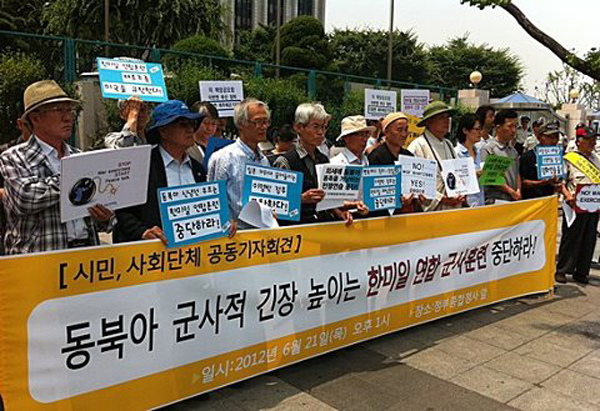
Jeju Islanders demand end to U.S.-Japan-South Korean war games which were conducted near the island,
June 21, 2012
A massive naval base in Gangjeong will destabilize both Korean and regional security while serving U.S. interests in an area of the world that the U.S. fears losing to China. Statements by Secretary of State Hillary Clinton and Secretary of Defense Leon Panetta are instructive. Arguing that the Asia Pacific region holds the key to America’s future, Clinton has stated that “[h]arnessing Asia’s growth and dynamism is central to American economic and strategic interests” and that these interests hinge on a “forward-deployed” U.S. posture within the region. Similarly, indicating that the U.S. is “concerned about China,” Panetta has stated that despite “budget constraints that we are facing in the United States…[t]he most important thing we can do is to project our force into the Pacific — to have our carriers there, to have our fleet there.”
U.S. “force projection” in the region, Panetta clarified, vitally depends on the 85,000 U.S. troops stationed in South Korea and Japan. Shifting its strategic focus from the Atlantic to the Asia Pacific region where it plans to concentrate 60 percent of its naval power, the U.S., “if anything,” Panetta made clear, intends to “strengthen our presence in the Pacific.” This reckless and arrogant policy positions regional partners as vehicles for U.S. power. It thoroughly disregards the profound impact that the militarization of Asian-Pacific oceans has on the lives of ordinary people and makes laughable Clinton’s assertion that the U.S., as an “advocate for universal human rights,” leads by example.
We stand with the courageous people of Gangjeong who protest this obscene violation of their lives, their environment, and their democratic processes. Joining our voices to theirs, we call on the South Korean government to stop the construction of the Jeju naval base and demand that the U.S. government respect the urgency of true peace and genuine security, as expressed by the people of Gangjeong. (November 26, 2011)
About Nodutdol
no-dut-dol/: 1. stepping stone; 2. home, opening, entryway; 3. bridging; 4. love and longing in separation; 5. reunification.
Based in New York City, Nodutdol is a community of first through fourth generation Koreans living in the U.S. We are a community that has families in both the south and north of Korea. We are diverse in our backgrounds and perspectives, but bound together by our shared sense of the Korean homeland that continues to suffer under division [with the understanding that the concept of 'home' may vary]. We are part of the Korean diaspora spread throughout the globe made up of artists, filmmakers, teachers, students, workers, professionals, young families, etc. who believe in social justice.
[TOP]
U.S. to Shift Bulk of Navy Ships to Asia-Pacific
The United States will deploy the majority of its naval forces to the Asia-Pacific region over the next decade, Secretary of Defense Leon Panetta announced in a recent speech to a security conference in Singapore. The move is part of a major shift in the global strategy of U.S. imperialism that puts China at the top of the U.S. target list.
The mobilization of warships will be accompanied by an increase in the number of military exercises conducted by the Pentagon in the region, involving air, sea and land forces. Most will be carried out in conjunction with countries that are openly or tacitly allied with the U.S. against China, including Japan, South Korea, Australia and the Philippines.
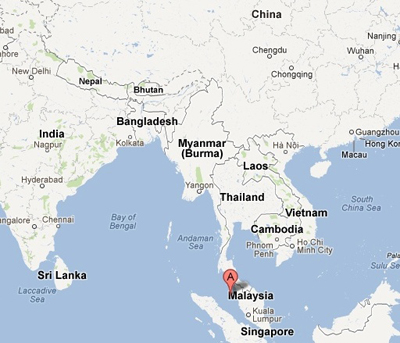 In his speech to the conference, Panetta elaborated on the “pivot to Asia” announced by Obama last year, in which he indicated that the withdrawal of U.S. forces from Iraq and the beginning of a drawdown from Afghanistan would allow the U.S. military to deploy far greater resources to the Far East.
In his speech to the conference, Panetta elaborated on the “pivot to Asia” announced by Obama last year, in which he indicated that the withdrawal of U.S. forces from Iraq and the beginning of a drawdown from Afghanistan would allow the U.S. military to deploy far greater resources to the Far East.
“All of the U.S. military services are focused on implementing the president’s guidance to make the Asia-Pacific a top priority,” Panetta said, adding: “While the U.S. military will remain a global force for security and stability, we will of necessity rebalance towards the Asia-Pacific region.”
The current deployment of the U.S. Navy is approximately a 50-50 split between the Atlantic and Pacific. This will change by 2020 to a 60-40 split in favor of the Pacific, Panetta said: “That will include six aircraft carriers in this region, a majority of our cruisers, destroyers, Littoral Combat Ships, and submarines.” He called these forces “the core of our commitment to this region.”
Panetta singled out for praise the agreement last fall with the Australian government for the deployment of U.S. Marines in northern Australia, calling it “a critical component” of the U.S. military buildup.
“This Marine Air-Ground Task Force will be capable of rapidly deploying across the Asia-Pacific region,” he said, thus confirming that it will be able to intervene at key choke points like the Strait of Malacca, vital to China’s export and import trade, particularly oil supplies from the Middle East and Africa.
The U.S. is negotiating a similar agreement for stationing ground forces on a rotating basis in the Philippines, he said, and is pursuing such arrangements with other countries in the region, although he did not name them. In 2011 the U.S. military conducted 172 military exercises in the Asia-Pacific region, and that number will increase considerably this year.
Panetta claimed that the U.S. buildup was not directed against China, and even made the Orwellian claim that “increased U.S. involvement in this region will benefit China as it advances our shared security and prosperity for the future.”
There is no mistaking the meaning of the measures he announced, however. More than half the US Navy is to be deployed to the Asia-Pacific. What other country could be the target? […] When Panetta declared, referring to US relations with China, “We in the United States are clear-eyed about the challenges,” all the conference participants, as well as Beijing, undoubtedly got the message.
If there were any doubts, Panetta closed his address with an invocation of the history of U.S. wars in the region. “Over the course of history, the United States has fought wars, we have spilled blood, we have deployed our forces time and time again to defend our vital interests in the Asia-Pacific region,” he declared. […]
Panetta held a trilateral meeting with South Korean National Defense Minister Kim Kwan Jin and Japan Parliamentary Senior Vice Minister of Defense Shu Watanabe to discuss joint operations against North Korea. […]
Panetta’s bilateral meeting with Singapore Minister of Defense Ng Eng Hen finalized the agreement for the stationing of four US littoral combat ships in the island state. These ships are designed to operate in near-shore environments, particularly against mines, submarines and small, light surface craft.
General Martin E. Dempsey, chairman of the Joint Chiefs of Staff, said the ships would be rotated in and out of Singapore for six to ten months at a time. The sailors will live on board and not be stationed or home-ported in Singapore. But the result is that at any one time, some 300 U.S. navy personnel will be in Singapore, keeping watch over the adjacent Strait of Malacca. The ships will also move about the region, to Malaysia, Indonesia, the Philippines and elsewhere in southeast Asia.
Following the Singapore conference, Dempsey traveled to the Philippines for meetings with President Benigno Aquino III and Lt. Gen. Jessie Dellosa, chief of staff of the Armed Forces of the Philippines. […] (Global Research, June 4, 2012)
[TOP]
